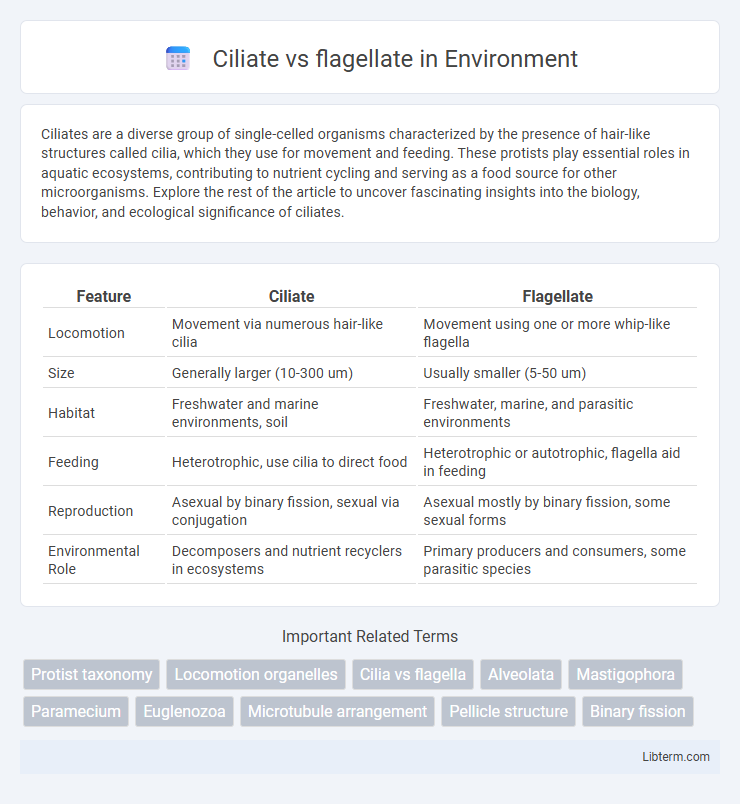Ciliates are a diverse group of single-celled organisms characterized by the presence of hair-like structures called cilia, which they use for movement and feeding. These protists play essential roles in aquatic ecosystems, contributing to nutrient cycling and serving as a food source for other microorganisms. Explore the rest of the article to uncover fascinating insights into the biology, behavior, and ecological significance of ciliates.
Table of Comparison
| Feature | Ciliate | Flagellate |
|---|---|---|
| Locomotion | Movement via numerous hair-like cilia | Movement using one or more whip-like flagella |
| Size | Generally larger (10-300 um) | Usually smaller (5-50 um) |
| Habitat | Freshwater and marine environments, soil | Freshwater, marine, and parasitic environments |
| Feeding | Heterotrophic, use cilia to direct food | Heterotrophic or autotrophic, flagella aid in feeding |
| Reproduction | Asexual by binary fission, sexual via conjugation | Asexual mostly by binary fission, some sexual forms |
| Environmental Role | Decomposers and nutrient recyclers in ecosystems | Primary producers and consumers, some parasitic species |
Introduction to Ciliates and Flagellates
Ciliates and flagellates are two distinct groups of protists characterized by their unique locomotive structures, with ciliates possessing numerous short hair-like cilia and flagellates bearing one or more long whip-like flagella. Ciliates use coordinated ciliary movement for locomotion and feeding, while flagellates employ flagellar undulations to propel through aquatic environments. Both groups play crucial roles in aquatic ecosystems, contributing to nutrient cycling and serving as key components in the microbial food web.
Defining Features of Ciliates
Ciliates are characterized by the presence of numerous short hair-like organelles called cilia, which cover their surface and enable locomotion and feeding through coordinated beating patterns. Unlike flagellates, which generally possess one or few long flagella, ciliates exhibit a complex pellicle and specialized oral structures for ingesting food particles. Their unique nuclear dimorphism, with distinct macronuclei and micronuclei, supports complex genetic processes distinct from those in flagellates.
Key Characteristics of Flagellates
Flagellates are unicellular organisms characterized by the presence of one or more whip-like appendages called flagella, which enable locomotion and feeding. These flagella rotate or whip to propel the organism through liquid environments, distinguishing them from ciliates that use short, hair-like cilia arranged in rows. Flagellates often have flexible cell membranes, allowing shape changes, and many are autotrophic or mixotrophic, utilizing photosynthesis or ingesting particles for nutrition.
Structural Differences: Cilia vs Flagella
Cilia are short, numerous, hair-like structures that cover the surface of ciliates, enabling coordinated movement and efficient feeding through synchronized beating patterns. Flagella are longer, fewer in number, and whip-like appendages found in flagellates, propelling the organism by undulating motions that allow more directional movement. Structurally, both cilia and flagella share the "9+2" arrangement of microtubules, but differ in length, abundance, and beating style, reflecting their specialized roles in locomotion and environmental interaction.
Movement Mechanisms in Ciliates and Flagellates
Ciliates move using numerous short hair-like structures called cilia that beat in coordinated waves to propel the organism or move fluids around it, offering precise control and agility. Flagellates rely on one or more long whip-like flagella that rotate or whip back and forth, enabling smooth, directional swimming. The differing lengths and beating patterns of cilia versus flagella fundamentally influence locomotion styles and environmental adaptations in these protists.
Ecological Roles and Habitats
Ciliates predominantly inhabit freshwater and marine ecosystems, where their rapid movement using numerous cilia facilitates efficient predation on bacteria and small protists, playing a crucial role in nutrient cycling and controlling microbial populations. Flagellates are found in diverse habitats ranging from aquatic environments to soil, where their whip-like flagella enable motility and feeding, often contributing to primary production as photosynthetic species or acting as important decomposers and symbionts. Both groups serve as essential components of the microbial food web, influencing energy flow and biogeochemical processes in ecosystems.
Reproduction and Life Cycles
Ciliates reproduce primarily through binary fission and undergo conjugation as a form of sexual reproduction, exchanging genetic material to increase diversity without producing offspring directly. Flagellates display a variety of reproductive strategies, including binary fission, schizogony, and sexual reproduction involving gamete fusion, depending on the species and environmental conditions. Life cycles of ciliates often include complex stages such as trophozoites and cysts, whereas flagellates may have simpler or more varied life cycles, sometimes involving multiple hosts or environmental stages.
Nutritional Strategies: How They Obtain Food
Ciliates primarily obtain food through phagocytosis, using their hair-like cilia to sweep bacteria, algae, and detritus into an oral groove leading to a food vacuole where digestion occurs. Flagellates rely on their whip-like flagella to create water currents that draw in particulate matter or prey, enabling heterotrophic species to engulf bacteria or small protists, while some flagellates are photosynthetic and use chloroplasts for autotrophic nutrition. Both groups exhibit diverse nutritional strategies ranging from phagotrophy to mixotrophy, adapting to varying environmental food availability.
Significance in Environmental and Medical Contexts
Ciliates play a crucial role in aquatic ecosystems by regulating bacterial populations and recycling nutrients, thus maintaining water quality and supporting food webs. Flagellates contribute significantly to carbon cycling through photosynthetic species and act as indicators of environmental changes, especially in soil and marine habitats. In medical contexts, some flagellates, such as Giardia and Trypanosoma, are pathogenic protozoa causing diseases like giardiasis and sleeping sickness, highlighting their significance in public health monitoring and control.
Comparative Summary: Ciliates vs Flagellates
Ciliates and flagellates are both protists distinguished by their locomotive structures: ciliates use numerous short hair-like cilia, while flagellates propel themselves with one or more long whip-like flagella. Ciliates typically exhibit complex cell organization with two types of nuclei (macronucleus and micronucleus), whereas flagellates generally have simpler single-nucleus arrangements. Ecologically, ciliates often play roles as predators on bacteria and smaller protists in aquatic environments, while flagellates include both free-living and parasitic species, adapting to various habitats from soil to marine ecosystems.
Ciliate Infographic

 libterm.com
libterm.com